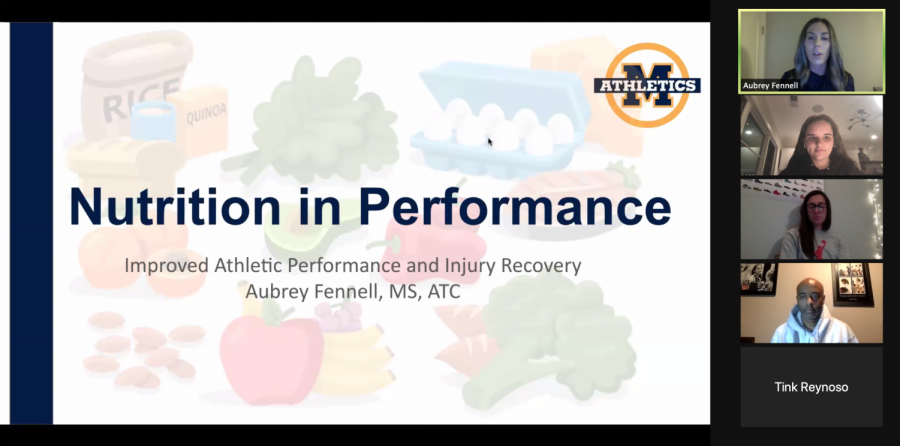New Menlo Program Focuses on Athlete Wellness
The Menlo Wellness program provides educational sessions for student athletes, families and other Menlo community members about physical and mental health. Staff photo: Danielle McNair.
November 4, 2020
Head Athletic Trainer Aubrey Fennell and Assistant Athletic Trainer Stephanie Swan worked with Director of Sports Performance and Wellness Jesse Lindenstein, as well as strength and conditioning coach Sam Leeper, to introduce the virtual Wellness Program at Menlo School in early October. This program is intended to inform coaches, athletes and parents in the Menlo community about physical health and maintaining a healthy lifestyle.
Inspiration for the program began when shelter-in-place orders began in early March, according to Swan. “The athletic department split staff into multiple teams to try and create new ways to engage students this year if athletics did not start or happen in its normal form,” Swan said. “[Lindenstein, Leeper, Fennell] and I were set on a team [where the] focus was student wellness.”
The first session, on Oct. 19, was about hydration and how athletes can calculate their sweat ratio. Students learned about the sweat rate, which tells athletes how much fluid they need before, during and after exercise. According to a study provided by Fennell, athletes often drink less water than their body actually needs to remain hydrated throughout strenuous exercise. “One interesting thing I learned is how vital it is to hydrate sufficiently before and after practice, not just while I am exercising,” junior Simone Adam said.
The second meeting covered goal setting and accomplishing long-term goals. The main idea was setting “SMART” goals, an acronym for specific, measurable, attainable, relevant and time-bound. The session included a discussion of common examples of goals set by members of the Menlo community and distinguished which of these are “SMART.”
The third meeting covered nutrition; more specifically, it covered the difference between protein, carbohydrates and fats. The purpose was to educate student athletes about developing healthy eating habits, which foods are beneficial before versus after practice and how to balance meals. The topics of future meetings will include getting sufficient amounts of sleep, building better leadership, injury prevention and effective communication.
Thus far, the Wellness Program has been successful in terms of turnout and feedback about the meetings. “I’m really happy with how the program is going,” Swan said. “We have had between 35 and 55 people join [each session], including coaches, students, staff and parents.” As the meetings progress, attendance continues to grow, according to Swan. “It has been really nice to see that people are enjoying it and learning things along the way. I’m hopeful that the program continues to have good attendance because we have some great guest speakers coming up in a few weeks,” Swan said.
Determining the success of a new program can be challenging because feedback tends to remain positive. “I would say it has been pretty successful and informative. It has definitely made me more aware and conscious of aspects outside of practice that really help me succeed as an athlete,” Adam said. For Swan, the biggest indicator that the program has been successful is overhearing students talk about the subject throughout the week.
The inaugural launch was this past fall; however, Fennell, Swan, Lindenstein and Leeper hope to expand the Wellness Program at Menlo. “I hope that this program is something that we can continue to run throughout the years,” Swan said. “I think the program for this year is a really good base of knowledge, and in the future, we hope to dive deeper into these subjects and add more.” In addition, Swan hopes to launch a Vimeo or YouTube channel to store recordings of the meetings and upload videos so that students can access them at any time.
Once COVID-19 is no longer a barrier, Fennell and Swan hope to conduct interactive Wellness Program discussions. “There are so many things that we could do, [such as] mini-labs about sweat rate, demonstrations on sugar content in drinks or even mini imagery sessions,” Swan said. When normal sports routines start again, the format and frequency would have to be adjusted, but the program is set up to be adaptable in the future.


